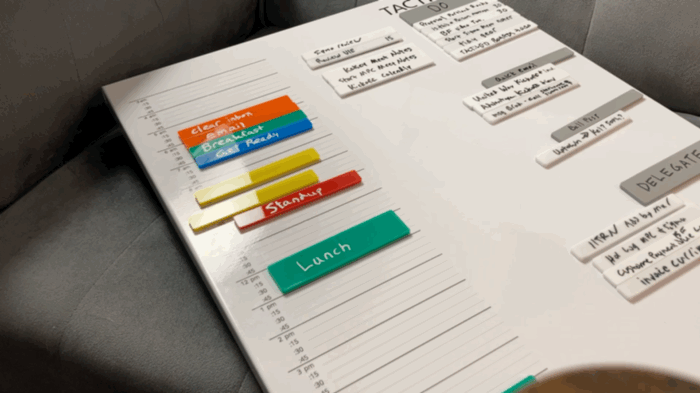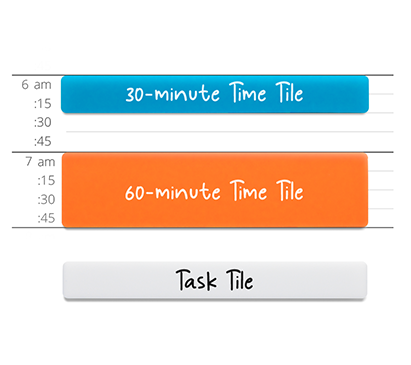In the video below, I walk you through how I use my TACTiLED Planner for time blocking a typical day. One thing I really like about this customized planner is there is no one way to use it. I am not locked into a single template (well, aside from the hours of the day – which can be easier to accept when planning with a physical board than when planning in my head).
I never set out to design a board for time blocking. In fact, I just came across “time blocking” as a concept last week when building this website and exploring videos to see how other people think about day planning. And when I thought about it, it seemed like exactly what I had been doing with the colored time tiles and the white task tiles. You can find some great time blocking tips here.
Time management is not a strength of mine (if you struggle with ADHD, you will understand). In my ADHD brain, tasks are infinite – if they are difficult or boring, they can take forever which is often why I find it hard to start on those types of tasks. Time on the other hand is finite, so finite, that I have joked most of my life about trying to future out how to make more time in the day. That’s probably why this approach works for me. I simply can’t put more time in the day and so I am forced to prioritize. But also, I can see that the “hard” stuff will be limited to a small window of time, making it much less intimidating.
Here is my first video ever made explaining how I use the board.
I learned recently that Elon Musk time blocks in 5-minute increments. That made me feel a bit better about my initial attempt to create 15-minute tiles. The issue here is they got very small with left me with the option to make my board. At 20-inches minimum, that didn’t seem like a great option. The other challenge there is planning takes time, and it’s well worth it, but it’s a bit like the law of diminishing returns for me. Thirty-minute blocks seemed to be the magic number, in terms of maintaining daily planning for weeks, and now months.
Did you know Benjamin Franklin used Time Blocking?
When researching day planning methods, I came across all kinds of greats that use the general idea of time blocking to plan their day.

In this example video, I start the day with one plan and blocks that don’t get used as planned are moved to an area of the board called “bumped.” And then in place of the block that was not used, I put a black tile identifying what was done instead. The great thing about this is that I end my day with a completed board regardless of what changed. I also learned a ton just from doing that on one day.

What I learned is that meetings always run long and proposals always take more time than anticipated. Even though I could have told you that, this presented me with the option to plan accordingly, change my working style (e.g. hard stop meetings) or change my board frequently. I started adding a 30-minute buffer at the end of each meeting and the problem was solved. With so many competing priorities, TACTiLED frees me up to focus on one thing at a time and feel successful when I do (vs. unsuccessful when I don’t complete all the tasks I’d hoped to). It’s a little bit like I’m my own ADHD coach or accountability buddy.
Visual Time Management

If you want to see a quick clip of the tiles and the real board (to get a feel for the quality), check out my about page. Or check out the shop to order your own TACTiLED Planning Set.
